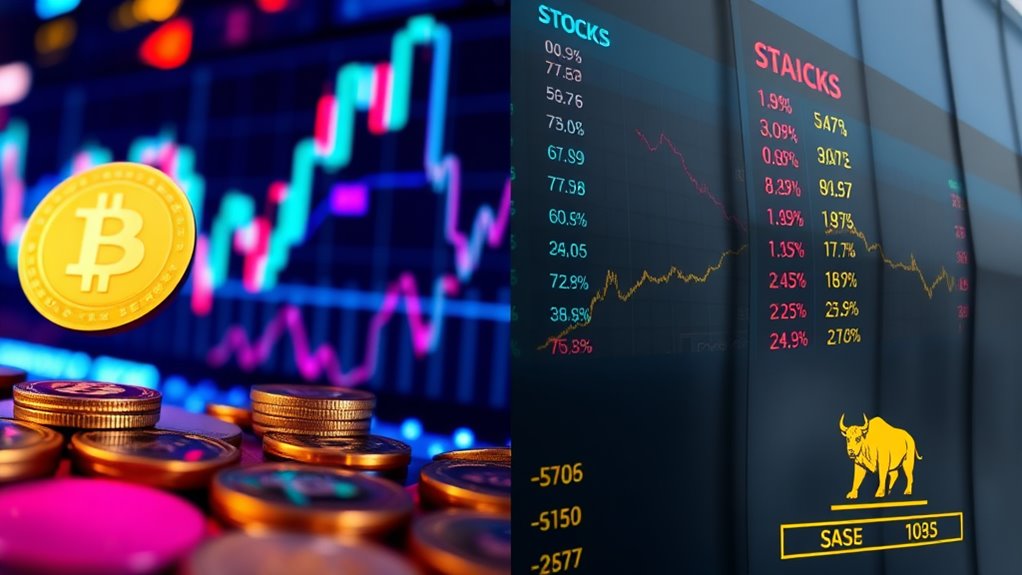
Cryptocurrency Vs Stocks: Key Differences & Investment Insights
Cryptocurrencies and stocks represent distinct investment vehicles with fundamental differences. Stocks offer ownership in companies with regulatory protection and relatively stable value tied to corporate performance. Cryptocurrencies operate on decentralized networks without government backing, featuring 24/7 trading and higher volatility. While stocks follow traditional market hours and established reporting standards, cryptocurrencies present potential for higher returns amid greater risk. Understanding these contrasts helps investors make informed decisions in today's evolving financial landscape.
Key Takeaways
- Cryptocurrencies trade 24/7 with higher volatility, while stocks follow regulated exchange hours and demonstrate more stable price movements.
- Stocks represent ownership in companies with regulatory protections, whereas cryptocurrencies operate on decentralized networks without government backing.
- Cryptocurrency investments averaged 49% annual returns over the past decade, outperforming traditional stock market gains but with greater risk.
- Stock markets have established reporting standards and SEC oversight, while cryptocurrency regulations vary by jurisdiction and are still evolving.
- Cryptocurrencies offer lower entry barriers for direct trading, but stocks provide more traditional investment vehicles with established broker relationships.
Core Asset Characteristics: Understanding Stocks and Cryptocurrencies

The fundamental differences between stocks and cryptocurrencies emerge through their distinct core characteristics, particularly regarding governance, ownership structure, and market dynamics.
While stocks represent ownership shares in companies, operating under established regulatory frameworks with shareholder voting rights and dividend potential, cryptocurrencies function on decentralized networks without traditional corporate structures.
Traditional stocks offer regulated ownership and voting rights, while cryptocurrencies provide decentralized value without corporate oversight or shareholder benefits.
Stocks are governed by company boards and regulatory bodies, providing investor protections and transparency through financial reporting requirements. In contrast, cryptocurrencies operate through blockchain technology, relying on network consensus and private key ownership rather than centralized authority.
These assets also differ in their accessibility and trading patterns, with cryptocurrencies available for trading 24/7 globally, while stocks typically trade during specified market hours and through regulated exchanges.
Unlike traditional stocks, cryptocurrencies derive their value primarily from market demand rather than government backing or underlying company assets.
Market Dynamics and Value Determination

The distinction between cryptocurrency and stock market dynamics becomes apparent through their price movement patterns, with cryptocurrencies exhibiting more dramatic swings due to their 24/7 trading nature and heightened sensitivity to market sentiment.
Supply and demand forces operate differently in these markets, as cryptocurrencies often have fixed or predetermined supply schedules, while stock supplies can be adjusted through corporate actions like splits or buybacks.
The relative maturity of stock markets provides more stable pricing mechanisms and established valuation methods, whereas cryptocurrency markets, being newer and less regulated, demonstrate more volatile reactions to market forces and emerging trends.
Additionally, investors should recognize that regulatory uncertainty in cryptocurrency markets creates unique challenges that traditional stock markets generally don't face.
Price Movement Patterns
Understanding price movement patterns reveals stark differences between cryptocurrency and stock markets, with each asset class exhibiting unique characteristics regarding volatility, market cycles, and value determination factors. While stocks typically follow more predictable patterns influenced by company performance and economic indicators, cryptocurrencies display heightened volatility driven by market sentiment and technological developments.
| Feature | Cryptocurrency | Stocks |
|---|---|---|
| Volatility | High, rapid swings | Moderate, gradual |
| Cycle Length | Shorter, intense | Longer, stable |
| Price Drivers | Sentiment, tech | Fundamentals, earnings |
Technical analysis tools like RSI and MACD help investors navigate both markets, though cryptocurrency patterns often show more dramatic formations. Chart patterns in crypto markets tend to develop and resolve more quickly, reflecting the asset class's inherent volatility and speculative nature compared to traditional stock movements. Unlike stocks, cryptocurrency valuations are heavily influenced by network effects and community adoption rates, which can amplify price movements in both directions.
Supply and Demand Forces
Supply and demand forces operate distinctly in cryptocurrency markets compared to traditional stock exchanges, creating unique market dynamics that influence value determination and price movements.
Unlike stocks, many cryptocurrencies feature fixed maximum supplies, such as Bitcoin's 21 million coin limit, which creates natural scarcity. This scarcity, combined with varying demand levels, can lead to significant price volatility.
Market participants, including institutional investors and retail traders, react to factors like media coverage, technological developments, and regulatory changes, which directly impact demand. The balance between limited supply and fluctuating demand plays a vital role in determining cryptocurrency values.
Additionally, mechanisms like token burns and mining reward halvings can affect supply dynamics, while adoption rates and investor sentiment drive demand patterns, contributing to the market's distinctive characteristics.
The growing adoption of decentralized finance applications has created new demand drivers in the cryptocurrency market, fundamentally reshaping traditional financial services and investment opportunities.
Market Maturity Impact
Market maturity differences between cryptocurrency and stock markets greatly shape how each asset class behaves and develops over time. While traditional stock markets have established mechanisms and regulatory frameworks developed over centuries, cryptocurrency markets are still evolving, resulting in distinct characteristics that affect investment decisions.
| Aspect | Stocks | Cryptocurrencies |
|---|---|---|
| Value Basis | Company Performance | Supply & Demand |
| Volatility | Moderate | High |
| Institutional Role | Well-established | Emerging |
The Decker Comparative Maturity Equation (DCME) demonstrates that increased institutional participation and regulatory clarity contribute to market stability. As cryptocurrency markets mature, they show signs of reduced volatility and deeper liquidity. However, the 24/7 trading nature and global accessibility of cryptocurrencies continue to influence their maturity trajectory differently from traditional stock markets. The emergence of central bank digital currencies by 2025 could further reshape how traditional and crypto markets interact and evolve.
Risk Assessment: Volatility and Market Influences

Risk assessment stands as a critical factor when comparing cryptocurrency and stock investments, with volatility serving as a primary metric for evaluating potential returns and losses.
Bitcoin's annualized volatility of 81% considerably exceeds typical stock market fluctuations, reflecting the cryptocurrency market's inherent unpredictability.
Market influences also differ greatly between these investment types. While stocks respond primarily to economic conditions and government policies, cryptocurrencies are more sensitive to adoption rates and market-specific events.
Traditional risk assessment tools, such as the Sharpe and Sortino ratios, indicate that despite higher volatility, Bitcoin has historically delivered stronger risk-adjusted returns compared to the S&P 500.
However, the cryptocurrency market's standard deviation remains remarkably higher, suggesting greater potential for both gains and losses.
Understanding fraudulent scheme risks and legitimate use cases is essential for developing a balanced perspective on cryptocurrency investments.
Regulatory Environment and Compliance Requirements

The regulatory landscape for stocks and cryptocurrencies presents stark contrasts, with traditional securities markets operating under well-established government oversight while cryptocurrency regulations remain fragmented across jurisdictions.
Stock exchanges must adhere to strict reporting requirements and transparency standards enforced by entities like the SEC, whereas cryptocurrency platforms face varying levels of scrutiny depending on their location and operational scope.
Global compliance requirements further highlight these differences, as traditional stock markets follow standardized international protocols, while cryptocurrency regulations can range from permissive frameworks in countries like Switzerland to outright bans in others.
Government Oversight Framework Comparison
Fundamental differences exist between governmental oversight of stocks and cryptocurrencies in the United States, creating distinct regulatory landscapes for each asset class.
While stocks operate under well-established frameworks monitored by the SEC, with strict requirements for financial disclosure and corporate governance, cryptocurrencies face a more fragmented regulatory environment.
Multiple federal agencies, including the SEC, CFTC, OFAC, and DOJ, share oversight responsibilities for digital assets, often with overlapping jurisdictions.
Stock exchanges must adhere to specific trading hours and listing requirements, whereas cryptocurrency markets operate continuously without centralized control.
Additionally, cryptocurrency businesses must navigate varying state-level regulations, such as New York's BitLicense, while maintaining compliance with federal KYC/AML requirements and sanctions protocols.
Exchange Reporting Standards
Significant differences exist between reporting standards for cryptocurrency and stock exchanges, reflecting their distinct regulatory environments and compliance requirements.
Stock exchanges operate under well-established frameworks, using Form 1099-B to report transactions, while cryptocurrency exchanges will shift to Form 1099-DA in 2025 for reporting digital asset transactions.
Stock brokers follow strict regulatory guidelines enforced by agencies like the SEC, maintaining detailed records of purchase dates and tax basis information.
In contrast, cryptocurrency exchanges face unique challenges, including data collection complexities, privacy concerns, and varying international regulations.
While both types of exchanges must comply with anti-money laundering rules, cryptocurrency platforms operate in a more evolving regulatory landscape, requiring adaptable reporting systems to address market volatility and emerging compliance requirements.
Investors can utilize tax-loss harvesting strategies to optimize their cryptocurrency portfolio's tax efficiency while maintaining compliance with reporting requirements.
Global Compliance Variations
Global compliance requirements for cryptocurrency and stock markets vary dramatically across jurisdictions, creating a complex web of regulatory frameworks that challenge market participants.
While traditional stock markets operate under well-established regulatory systems, cryptocurrency regulations differ markedly between nations.
The European Union leads with its thorough MiCA framework, while the United States applies existing securities laws to crypto assets.
Japan and Australia mandate exchange registration with their respective financial authorities, implementing strict AML/KYC requirements.
In contrast, China maintains an outright ban on cryptocurrency trading.
Some nations, like Brazil and South Korea, have introduced specific crypto legislation to protect users and prevent financial crimes.
These variations in regulatory approaches affect how investors can participate in cryptocurrency markets compared to traditional stock exchanges, requiring careful consideration of jurisdictional requirements.
Thoughtful regulation could help legitimize cryptocurrencies while preventing their misuse in illicit activities.
Trading Mechanics and Market Accessibility

When examining the mechanics and accessibility of trading in both cryptocurrencies and stocks, several key differences emerge in how these assets are bought, sold, and managed.
Cryptocurrency trading offers unique advantages through specialized exchanges and CFD platforms, operating 24/7 with generally higher liquidity than traditional stock markets.
The entry barriers for cryptocurrency trading tend to be lower, with investors able to start trading directly on digital platforms without the need for traditional brokers.
While stock trading is confined to specific market hours, cryptocurrency markets remain continuously active, enabling global participation across time zones.
Trading platforms provide various order types, including market, limit, and stop orders, supporting different trading strategies from scalping to long-term position holding.
The rapid execution speeds and worldwide accessibility make cryptocurrencies particularly suitable for short-term trading approaches.
Most cryptocurrency exchanges require users to complete identity verification processes before allowing access to trading features, ensuring compliance with regulatory standards.
Investment Returns and Asset Utility

The investment landscape for cryptocurrencies and stocks presents distinct patterns of returns and practical applications for investors. While stocks represent ownership in companies and operate within regulated markets, cryptocurrencies function primarily as speculative assets with higher volatility and potential returns.
- Historical performance data shows Bitcoin's average annual return of 49% over the past decade, considerably outperforming traditional markets, though with substantially higher risk as measured by its Sharpe ratio of 1.3.
- Stocks appeal to long-term investors seeking stability through regulated markets, while cryptocurrencies attract those comfortable with higher risks and short-term trading opportunities.
- Investment utility differs markedly, with cryptocurrencies offering enhanced liquidity and rapid transactions, though facing greater susceptibility to market manipulation and regulatory uncertainty compared to traditional stocks.
The growing integration of institutional adoption and enhanced regulatory frameworks is expected to bring increased stability to cryptocurrency markets by 2025, potentially reducing the stark contrast in risk profiles between digital assets and traditional stocks.
Portfolio Strategy and Risk Management

Strategic portfolio management and risk assessment require fundamentally different approaches when dealing with cryptocurrencies versus traditional stocks.
While stocks operate within established regulatory frameworks and offer diversification across industries and geographies, cryptocurrencies present unique challenges due to their heightened volatility and evolving regulatory landscape.
Effective portfolio strategy often involves balancing these assets based on individual risk tolerance and investment horizons. Investors typically allocate a smaller percentage to cryptocurrencies due to their speculative nature, while maintaining a larger portion in stocks for stability.
The 24/7 trading availability of cryptocurrencies offers increased liquidity but demands more active monitoring. Additionally, consideration must be given to transaction costs, tax implications, and the psychological aspects of managing volatile assets.
Successful portfolio management requires understanding these distinct characteristics and adjusting allocation strategies accordingly.
Frequently Asked Questions
Which Asset Class Performs Better During Periods of High Inflation?
During high inflation periods, certain stocks, particularly in utilities and essential sectors, tend to perform more reliably. While cryptocurrencies are sometimes considered inflation hedges, their performance remains inconsistent and highly volatile during inflationary times.
Can Cryptocurrencies and Stocks Be Directly Exchanged for One Another?
Cryptocurrencies and stocks cannot be directly exchanged for one another. These assets must be traded separately through their respective platforms – cryptocurrency exchanges for digital assets and regulated stock exchanges for equities.
How Do Geopolitical Events Impact Cryptocurrency Prices Compared to Stocks?
Geopolitical events typically cause more volatile price movements in cryptocurrencies compared to stocks, due to their decentralized nature and speculative trading. Cryptocurrencies often experience sharper reactions to global political developments.
What Role Do Social Media Influencers Play in Cryptocurrency Versus Stock Prices?
While influencers impact both markets, their effect on cryptocurrency prices is significantly stronger. Social media personalities can trigger rapid price swings in crypto, whereas stock prices generally show more resistance to influencer-driven volatility.
Is There an Age Demographic Difference Between Cryptocurrency and Stock Investors?
Cryptocurrency investors are mainly younger, with 94% being Gen Z and Millennials under 40. Stock market investors represent a broader age distribution across generations, with no single age group dominating participation.
Conclusion
Both stocks and cryptocurrencies offer unique investment pathways, each with distinct characteristics and risk profiles. While stocks provide traditional ownership in established companies with regulatory oversight, cryptocurrencies represent an emerging digital asset class with potentially higher volatility. Investors must carefully weigh their risk tolerance, investment goals, and market understanding when choosing between these options, as success often lies in developing a balanced portfolio strategy aligned with individual circumstances.












